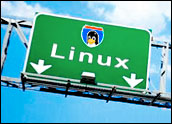
Linux inched ahead in the operating-system arena during the final month of 2009, even as Windows and Mac gave up some ground.
That’s according to research firm Net Applications, which recently released its Market Share report covering operating systems in December.
Linux accounted for 1.02 percent of the market in December, up from an even 1 percent the month before, Net Applications reported.
A Peak in May
Windows, meanwhile, fell from 92.52 percent in November to 92.21 percent in December, while Mac fell from 5.12 percent to 5.11 percent during the same time, the company found.
Linux’s market share was 0.98 percent in February 2009, peaking for the year at 1.17 percent in May, according to Net Applications’ data.
Windows was at 94.74 percent in February, while Mac was at 4.55 percent.
Also tracked by Net Applications are Java ME, iPhone, Symbian, iPod touch, Windows Mobile, Android and a variety of other systems.
Rival Data
Of course, estimates for Linux’s market share are notoriously variable and controversial, given that — unlike other operating systems — there is very little sales data.
Rival tracking site W3Counter, in fact, puts Linux’s market share at a significantly higher 2.14 percent for the month of December, up from 1.8 percent the month before.
Windows — including XP, Vista, 7, 2003, 2000 and 98 versions — went from 85.69 percent in November to 86.43 percent in December, while Mac fell from 7.46 percent to 7.44 percent, according to W3Counter.
Advocates of free and open source software, meanwhile, estimate that Linux’s share may even be in the double digits.
‘Just Noise, Statistically Speaking’
The fact that the changes in market share for each of the three platforms were so tiny — according to Net Applications’ data, anyway — makes it difficult to interpret their meaning, Stephen O’Grady, an analyst with RedMonk, told LinuxInsider.
“It’s likely just noise, statistically speaking,” O’Grady said.
The decline in Windows’ market share, for example, “could easily be attributable to holiday vacations, given the derivation of the data,” he pointed out.
“In other words, it’s a small sample size and therefore impossible to draw any real conclusions from it,” O’Grady asserted.
Influencing Factors
“It’s clear that a .02 percent increase for Linux does not mean a whole lot when it’s going from 1.0 percent to 1.02 percent, particularly when Windows is still above 90 percent and Mac is practically unchanged at 5.1 percent,” agreed Jay Lyman, an analyst for enterprise software with the 451 Group.
That said, however, “there are a few things happening to increase the desktop market share for Linux,” Lyman told LinuxInsider.
First, outside of the United States, “Linux is still accounting for one-third of operating systems shipped on netbooks, according to most accounts,” he pointed out.
Holiday shopping could also have helped bump Linux’s share up for December, he added.
Then again, there’s also “a new generation of computer scientists, developers and IT administrators who are exposed to and experienced with Linux more than ever, and we expect this trend to help drive Linux on the desktop to some degree,” Lyman asserted. “This could also account for a December boost for Linux, since more students and developers might have time for tinkering.”
‘A Very Quiet Creep’
Finally, “the idea of a computer OS is no longer limited to desktop and notebook PCs, so as convergence continues to blur the line between the PC and the smartphone, Linux is well-positioned to grow because of its flexibility, cost and other advantages,” Lyman noted.
Whether or not these “more indirect and discreet gains will be measurable or noticed,” of course, is another question, he added.
Still, “I expect a very quiet creep for Linux in the OS market,” Lyman concluded, “particularly in desktop and consumer devices.”




















































I wonder how these things are measured. If it’s just on what is sold with a machine then it’s going to give a very skewed view of what’s actually being used out there in UserLand. I use six operating systems on a daily/weekly basis: 2 Mac, 3 Linux, 1 Windows. Only three of those systems are ones that actually came with the computers.
I’d be more interested in the stats of what people are actually using, not so much what they buy with their machine.